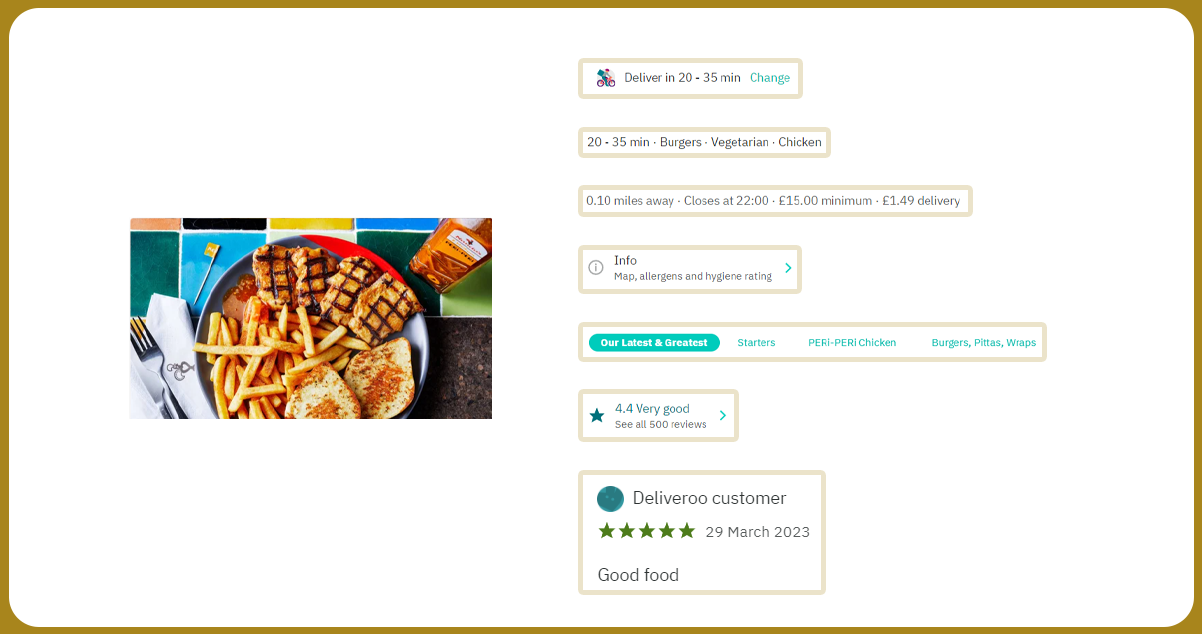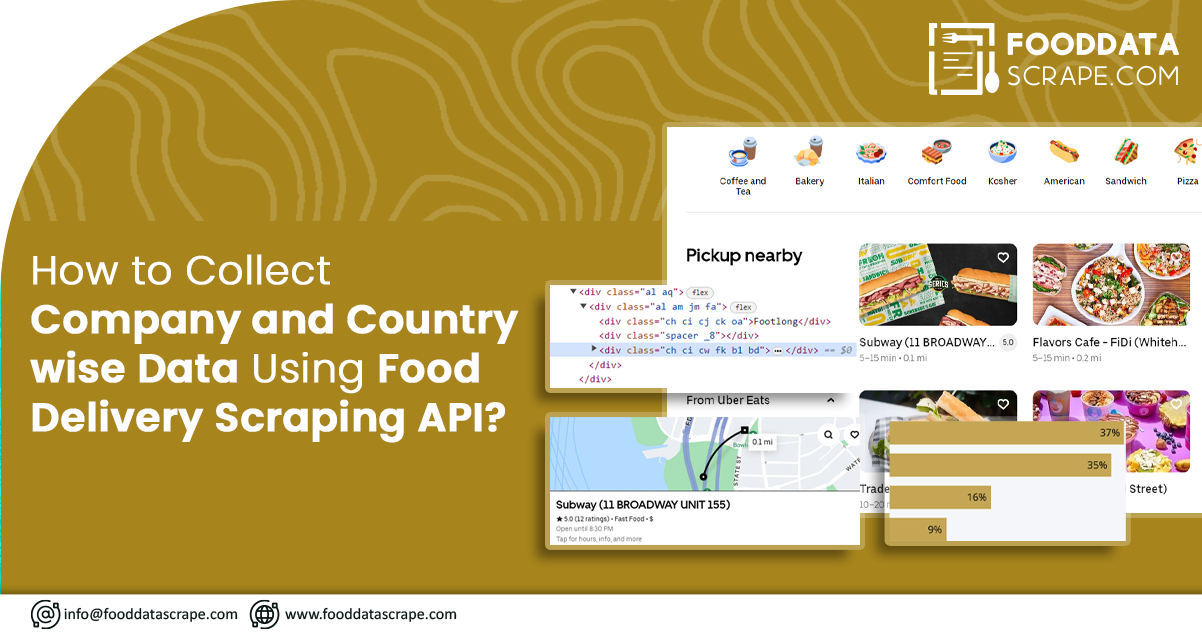Web scraping food delivery data is a dynamic process that involves extracting valuable information from online platforms and applications that offer food delivery services. This practice is instrumental in an era where convenience and quick access to food are paramount. Businesses can gain competitive insights, optimize delivery services, and adjust pricing strategies by collecting data on restaurant menus, prices, delivery times, customer reviews, and location-based offerings using food delivery scraping API. Consumers can compare menus and prices, read reviews, and make informed choices for their culinary cravings. Web scraping food delivery data is vital for the food industry and consumers seeking convenience and variety in their dining experiences.
Reasons to Scrape Food Delivery Data Company-wise and Country-wise

Scraping food delivery data company-wise and country-wise empowers businesses with insights for competition analysis, menu adaptation, pricing optimization, and compliance with local regulations. It also enables food delivery platforms to cater to local tastes, navigate regional regulations, and plan successful expansions into new markets.
Company-Wise:
Competitive Analysis: Understanding different food delivery companies' menus, pricing, and delivery options allows restaurants and food businesses to assess their competitors and refine their offerings.
Menu Trends: Analyzing data by company helps identify emerging menu trends, enabling restaurants to adapt and diversify their offerings to meet consumer demands.
Pricing Strategy: Monitoring the pricing strategies of various companies helps businesses optimize their pricing models, ensuring they remain competitive.
Customer Reviews: Tracking customer reviews and ratings for specific companies helps businesses gauge customer sentiment and identify areas for improvement.
Marketing Insights: By analyzing marketing tactics employed by different food delivery companies, businesses can refine their marketing strategies for better customer acquisition.
Country-Wise:
Local Preferences: Each country has unique culinary preferences and dietary habits. Scraping data country-wise helps tailor menus and offerings to local tastes.
Regulatory Compliance: Food delivery is subject to varying regulations in different countries. Collecting data country-wise ensures compliance with local laws and regulations.
Supply Chain Management: Understanding local supply chain dynamics is crucial for timely deliveries, and country-specific data aids in optimizing supply chain operations.
Pricing Variability: Economic factors, consumer behavior, and local competition can vary pricing. Country-wise data helps set competitive pricing strategies.
Expansion Planning: For food delivery companies looking to expand into new markets, country-wise data provides valuable insights into market potential and feasibility.
At Food Data Scrape, we offer a specialized food delivery scraping API to collect comprehensive restaurant delivery data country-wise and company-wise tailored to specific countries. For example, Hong Kong Deliveroo, Indonesia Grab Food, Deliveroo, Philippines Grab Food, Deliveroo, India Swiggy, Zomato, UAE Deliveroo, Careem, Carriage, etc., are a few. Deliveroo in Hong Kong is a popular food delivery service that connects customers with a wide range of local restaurants, offering a convenient way to enjoy delicious meals delivered to their doorstep. We can help scrape Hong Kong food delivery data to provide you with valuable insights into restaurant menus, prices, delivery times, and customer reviews, enabling informed dining choices and market analysis. Similarly, Zomato in India is a well-established and widely used online platform that connects users with a multitude of restaurants and eateries, offering comprehensive dining options, reviews, and online food ordering services for customers across the country. We also help scrape India food delivery data, enabling you to access a wealth of information on menus, prices, restaurant ratings, and delivery services, facilitating data-driven decisions and market analysis. Our API empowers businesses and food delivery platforms to access detailed insights into menus, pricing, delivery times, and customer reviews, all specific to their target regions. Whether you're seeking to refine your local offerings, navigate country-specific regulations, or plan international expansions, our API provides the data you need to make informed decisions and stay competitive in the ever-evolving food delivery landscape.
List of Data Fields

- Restaurant Information
- Menu Items
- Pricing
- Delivery Options
- Ratings
- Regions Reviews
- Popular Flavors
- Popular Restaurant
- Popular Cuisines
- Order History
- User Profiles
- Payment Methods
Basic Steps Involved in Scraping Food Delivery Data

- Data Source Identification: We identify the food delivery platforms or websites from which we want to extract data, ensuring they align with our client's objectives.
- Data Collection: Using a restaurant data scraper, we systematically collect data, including restaurant details, menus, prices, and customer reviews, from the identified sources.
- Data Parsing: The collected raw data is parsed and structured into organized formats, making it easier for analysis and integration.
- Data Validation: Our rigorous validation process ensures data accuracy by eliminating duplicates and correcting errors, ensuring the highest data quality.
- Data Transformation: We convert the scraped data into various formats, such as CSV, JSON, or databases, according to client preferences.
- Data Delivery: Finally, we deliver processed and structured data to our clients, ready for analysis, decision-making, and other business applications. We aim to provide clients with valuable insights to optimize their operations and strategies in the food delivery industry.
Data Delivery in Dashboard View

In addition to our versatile data delivery options, which include CSV, Excel, and JSON formats, food delivery data scraping services prioritize user convenience by offering an intuitive dashboard on our landing page. This dashboard features a comprehensive list of countries linked to a dedicated food and restaurant delivery data feed. This accessibility simplifies data usage, empowering our clients to effortlessly navigate and analyze data specific to their areas of interest. Whether it's market trends, menu insights, or delivery preferences, our user-friendly interface ensures businesses can harness our rich food delivery data for informed decision-making and strategic planning in the dynamic and competitive food industry.
Conclusion: Restaurant data scraping, when performed company-wise and country-wise, provides invaluable insights and strategic advantages to businesses operating in the food and hospitality industry. Collecting data on a company-by-company basis allows for in-depth competitor analysis, menu optimization, and pricing strategy refinement. Simultaneously, scraping data on a country-wide level enables businesses to cater to local preferences, navigate regulations, and identify expansion opportunities in specific regions. Together, these approaches enhance market intelligence, operational efficiency, and decision-making. As the restaurant landscape evolves, harnessing data scraping techniques in both dimensions empowers organizations to stay competitive, customer-focused, and responsive to ever-changing market dynamics.
For more in-depth information, feel free to contact Food Data Scrape today! We're also here to assist you with any of your needs related to Food Data Aggregator and Mobile Restaurant App Scraping services. We also provide advanced insights and analytics that offer valuable data-driven perspectives to drive informed decision-making and enhance business strategies.
Get in touch
Get in touchWe will Catch You as early as we recevie the massage
Trusted by the best of the food industry

























































































